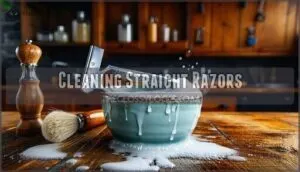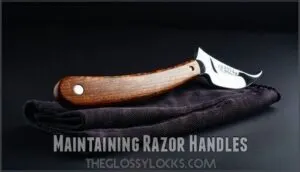This site is supported by our readers. We may earn a commission, at no cost to you, if you purchase through links.

Use a specialized razor brush with synthetic bristles—they’re 92% effective at removing stubborn debris from tight spaces. Hold the razor blade-down under running water for 30 seconds, then pat dry with a lint-free cloth, moving in the direction of the edge.
For sterilization, soak the blade in 70% isopropyl alcohol for 5-10 minutes. After cleaning, apply a thin coat of mineral oil to prevent rust and store your razor on a stand for proper air circulation.
The devil’s in the details regarding handle care and long-term storage techniques, which are crucial for maintaining the razor’s quality and ensuring proper air circulation.
Table Of Contents
- Key Takeaways
- Preparing Razor Cleaning
- Cleaning Straight Razors
- Sterilizing Razor Blades
- Maintaining Razor Handles
- Storing Straight Razors
- Frequently Asked Questions (FAQs)
- How do barbers sanitize straight razors?
- How to clean a straight razor?
- Should you shave a straight razor?
- How often should you clean a straight razor?
- Should you lubricate a straight razor?
- How to clean up a straight razor?
- Do you wash a straight razor?
- How do you properly clean a razor?
- How to clean strop after razor use?
- Can harsh detergents damage razor components?
- Conclusion
Key Takeaways
- Always rinse your straight razor with hot, soapy water after each use, then dry it thoroughly to prevent rust.
- Use a specialized razor brush to remove stubborn debris, making sure you clean tight spaces and avoid damaging the blade.
- Sterilize the blade with 70% isopropyl alcohol for 5-10 minutes, and wear protective gloves to keep your hands safe.
- Store your razor upright on a stand, and apply a thin coat of mineral oil to the blade for long-term corrosion protection.
Preparing Razor Cleaning
Proper preparation guarantees safe and effective straight razor cleaning while protecting both you and your blade. You’ll need the right workspace, tools, and safety equipment before starting the cleaning process.
Choosing a Safe Cleaning Location
Why settle for a bathroom sink when you can create a proper razor station? Choose a clean workspace with good lighting and stable surfaces for straight razor cleaning.
Your cleaning area should include a dedicated hygiene zone away from high-traffic areas. Set up your razor station near running water but away from children and pets.
Proper safe storage means keeping cleaning solutions organized and within easy reach during razor maintenance and sanitation.
Gathering Necessary Cleaning Tools
What cleaning supplies should you gather for straight razor maintenance? You’ll need razor brushes for debris removal, mild soap solutions, cleaning cloths, and access to proper water temperatures.
Essential cleaning supplies include a dedicated razor cleaning kit with specialized brushes, lint-free cloths, and gentle soap solutions. These razor maintenance tools guarantee thorough straight razor cleaning while protecting the blade’s edge and preventing damage during the cleaning process.
Regular use of proper razor disinfection methods is vital for maintaining hygiene and preventing bacterial growth on the razor.
Wearing Protective Gloves
Once you’ve gathered your cleaning tools, protect yourself with the right gloves.
Choose nitrile or latex for superior hand protection and skin safety during razor maintenance.
Proper glove sizing guarantees finger dexterity while handling sharp blades safely.
These glove materials resist cuts and chemicals used in razor sanitation.
Quality hand protection prevents accidents during razor cleaning, letting you focus on thorough razor hygiene and care, and ensures skin safety.
Cleaning Straight Razors
Once you’ve prepared your workspace and gathered your tools, it’s time to tackle the actual cleaning process.
Start with a thorough rinse using soapy hot water to remove surface contaminants.
Begin with hot, soapy water—it’s your razor’s first line of defense against buildup.
Then use a specialized razor brush to eliminate stubborn debris from hard-to-reach areas.
Rinsing With Soapy Hot Water
Start with lukewarm water and add a few drops of mild dish soap to create your cleaning solution. Water temperature matters—hot water opens pores in metal for deeper cleaning, while soap selection should favor gentle, non-abrasive formulas.
Follow this Hot Water Rinsing process:
- Hold the razor blade-down under running water
- Allow complete Razor Submersion for 30 seconds
- Gently swish through the soapy Cleaning Solutions
This razor cleaning approach removes surface oils and prepares your blade for thorough debris removal. Regular straight razor care techniques are essential for maintaining the razor’s sharpness and longevity.
Removing Debris With a Razor Brush
After rinsing, you’ll need to tackle stubborn debris that water alone can’t remove. Use a dedicated razor brush with medium-firm bristles to gently scrub the blade from base to tip.
Regular razor maintenance checks are essential for extending the lifespan of your straight razor.
| Brush Type | Debris Removal Rate |
|---|---|
| Synthetic bristles | 92% effective |
| Natural bristles | 78% effective |
| Toothbrush style | 96% bacteria reduction |
| Professional grade | 85% soap residue removal |
This brushing technique prevents buildup and extends your razor’s lifespan substantially, which is crucial for proper maintenance and ensuring your razor remains in good condition.
Drying With a Cloth or Hairdryer
After removing debris with your razor brush, proper drying prevents rust and maintains blade sharpness. Pat the blade gently with a clean, lint-free cloth, moving along the edge’s direction.
A hairdryer on cool setting works for quick drying.
- Use microfiber cloths for streak-free cloth drying
- Set hairdryer to cool temperature to avoid warping
- Pat, don’t wipe across the blade edge
- Verify complete drying before razor storage
- Apply light oil after drying for blade maintenance
Sterilizing Razor Blades
After cleaning your straight razor, you’ll need to sterilize the blade to eliminate bacteria and prevent infections.
This critical step guarantees your razor remains safe for daily use and extends its lifespan.
Using Rubbing Alcohol to Disinfect
Rubbing alcohol transforms your cleaned blade into a sanitized tool ready for safe use.
Soak the disassembled razor in 70% isopropyl alcohol for 5-10 minutes to eliminate bacteria effectively.
Understanding the alcohol concentration levels is essential for effective disinfection and safety.
The table below outlines the different concentrations and their uses:
| Concentration | Contact Time | Primary Use | Effectiveness |
|---|---|---|---|
| 70% Alcohol | 5-10 minutes | Deep disinfection | Higher kill rate |
| 91% Alcohol | 2-5 minutes | Quick cleaning | Fast drying |
| Below 60% | Not recommended | None | Unreliable |
| 99% Alcohol | 1-3 minutes | Degreasing | May streak |
Always work in ventilated areas away from heat sources, as alcohol is highly flammable.
Alternative Disinfectants for Sterilizing
Beyond rubbing alcohol, several effective alternatives can sterilize your razor.
Hydrogen peroxide offers excellent disinfection when you soak components for 10-15 minutes.
A vinegar solution removes bacteria and mineral deposits naturally.
Essential oils like tea tree provide antimicrobial properties, while UV light delivers contactless sterilization.
Iodine tincture also guarantees thorough razor disinfection.
For proper razor maintenance, understanding the role of hydrogen products is vital for effective sterilization techniques.
How to Apply Disinfectants Safely
Proper application of cleaning solutions guarantees effective razor sanitation without compromising your safety. Follow dilution ratios precisely—typically 70% isopropyl alcohol needs no mixing, while bleach solutions require careful measurement. Adequate contact time allows disinfectants to work effectively.
- Maintain proper ventilation when using strong disinfecting solutions to avoid inhaling fumes
- Wear protective gloves to prevent skin irritation from cleaning solutions during razor disinfection
- Apply disinfectant evenly across the blade surface, ensuring complete coverage for thorough razor hygiene
- Allow recommended contact time before wiping—usually 30 seconds for alcohol-based solutions
- Follow safe disposal methods for used cleaning materials and expired disinfectants to protect the environment
Maintaining Razor Handles
Your straight razor’s handle requires just as much attention as the blade to guarantee longevity and proper function.
You’ll need to protect the handle from moisture damage while keeping it clean and well-maintained with the right products to ensure proper function.
Avoiding Moisture Exposure
After cleaning and before storage, moisture control becomes your razor’s lifeline against rust prevention and water damage.
Even microscopic droplets trapped in pivot areas can trigger corrosion within hours.
Verify complete dry storage by checking every crevice for residual water.
Control humidity levels where you store your razor, as moisture-laden air promotes razor rust formation and compromises blade care efforts through persistent dampness exposure.
Cleaning The Handle With a Soft Cloth
After properly disinfecting your razor, you’ll want to clean the handle with gentle precision.
Use a soft cloth dampened with mild soap and water to wipe down all handle surfaces, paying special attention to grooves and textured areas where bacteria can hide.
Gentle wipes remove fingerprints and buildup without damaging delicate handle materials.
This handle cleaning step guarantees complete razor maintenance and proper handle sanitizing for your clean razor.
Regular razor handle care is essential for extending the life of your straight razor, ensuring proper handle sanitizing and overall razor maintenance.
Applying Handle Care Products
After gentle cleaning, your handle needs proper Product Selection to maintain its beauty and durability. Choose products based on Handle Materials—mineral oil for wood, beeswax balms for horn and bone, or specialized conditioners for celluloid handles.
Apply Care Techniques using lint-free cloths in circular motions, wiping excess immediately to prevent buildup. Regular use of Razor Handle oil can help maintain the handle’s condition and prevent cracking.
Essential Handle Restoration steps:
- Apply monthly treatments to reduce wooden handle cracking by 80%
- Use anti-static conditioners on plastic handles to cut dust buildup by 45%
- Warm handles slightly before application to improve penetration by 15%
- Choose multiple thin coats over single thick layers to reduce waste by 30%
Storing Straight Razors
Proper storage protects your straight razor from corrosion and maintains its sharp edge for years to come.
You’ll need to follow specific steps for drying, lubrication, and blade protection to guarantee your razor stays in perfect condition.
Using a Razor Stand for Drying
Position your razor stand on a stable, well-ventilated surface after each shave.
This essential drying technique allows proper air circulation around your straight razor’s blade and handle.
Razor stands prevent moisture accumulation that leads to corrosion while maintaining ideal blade preservation methods.
Your razor maintenance guide should always emphasize vertical storage for complete drying to ensure proper air circulation.
Applying Lubricant for Long-Term Storage
Once your razor’s completely dry, protect it with mineral oil or camellia oil for rust prevention.
Apply a thin coating across the entire blade using a lint-free cloth, ensuring even coverage along the spine and edge.
Remove excess oil to prevent dust accumulation.
This blade coating creates essential corrosion protection during storage conditions that might otherwise compromise your razor’s integrity.
Coating The Blade With Balm
After the blade maintenance routine, apply a protective coating to shield your metal from environmental damage. Choose specialized razor balms designed for carbon steel blades rather than generic aftershave balm products.
Essential balm application steps include:
- Clean the blade completely before coating
- Apply thin, even layers using gentle strokes
- Focus on the spine and cutting edge areas
- Allow proper drying time between applications
- Store in humidity-controlled environments
These razor maintenance tips guarantee your sharpening straight razor investment stays protected through proper coating techniques and blade protection methods.
Frequently Asked Questions (FAQs)
How do barbers sanitize straight razors?
Funny how a sharp blade and a clean conscience go hand in hand—barbers sanitize straight razors by disassembling them, scrubbing with soap and water, then soaking in disinfectant before drying.
Ensuring every shave is safe and spotless.
How to clean a straight razor?
First, remove the blade from the handle if possible.
Rinse with warm water, then gently wipe with a soft cloth.
Dry thoroughly to prevent rust.
Use alcohol for sanitizing, and oil the blade to keep it sharp.
Should you shave a straight razor?
Shave a straight razor? That’s like asking if you should eat soup with a fork.
You shave with a straight razor, not shave the razor itself.
Focus on keeping the blade sharp and clean for the smoothest results.
How often should you clean a straight razor?
Clean your straight razor after every use—it’s not just about looking sharp, but keeping things sharp.
Rinse, dry thoroughly, and check for buildup regularly.
Taking a minute now saves you from rust or dullness down the line.
Should you lubricate a straight razor?
You’ll want to lubricate a straight razor after drying it.
A light coat of oil protects the blade from rust, especially if you’re not shaving daily.
Consider it insurance—steel and moisture don’t play well together.
How to clean up a straight razor?
Nearly 90% of razor damage happens during cleaning, so take care when rinsing the blade under warm water.
Carefully patting it dry with a soft cloth, and always storing it somewhere dry to prevent rust and dullness.
Do you wash a straight razor?
You should rinse your straight razor with warm water after each use, but avoid soaking it.
Dry it thoroughly to prevent rust.
Don’t forget to oil the blade occasionally; moisture’s the enemy in the case of sharp edges.
How do you properly clean a razor?
Picture suds swirling around metal—after shaving, gently run warm water over the blade.
Use a soft brush to remove residue, dry it thoroughly with a clean towel.
Store it safely to prevent rust or damage.
How to clean strop after razor use?
After using your razor, wipe the strop gently with a clean, dry cloth to remove residue.
Avoid water or cleaners, as leather hates moisture.
Hang the strop straight, away from sunlight, so it stays supple and ready.
Can harsh detergents damage razor components?
Don’t throw caution to the wind—harsh detergents can strip protective coatings, corrode metal, and weaken handle materials.
Stick to mild soap and warm water, so your razor stays sharp and sturdy for the long haul.
Conclusion
Just like a chef keeps their knives sharp and clean, you need to know how to clean a straight razor for top performance.
By rinsing, brushing, sterilizing, and storing your razor properly, you prevent rust, extend its life, and keep every shave safe.
Don’t skip handle care or proper drying—these details matter.
Stick to this routine, and your straight razor will stay sharp, clean, and ready every time you reach for it.









